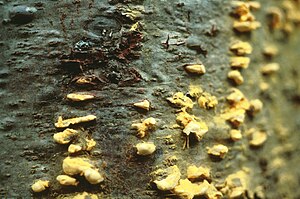White pine blister rust
| White pine blister rust | ||||||||||||
|---|---|---|---|---|---|---|---|---|---|---|---|---|

Äcidiosporenlager on Strobenstamm |
||||||||||||
| Systematics | ||||||||||||
|
||||||||||||
| Scientific name | ||||||||||||
| Cronartium ribicola | ||||||||||||
| JC fisher |
The Cronartium ribicola , strobing-blister rust or Strobenrost ( Cronartium ribicola ) is a pathogen from the family of Cronartiaceae , the swellings resin flow and orange yellow Aecien five noble pines such as Weymouth pine and pineal jaw causes and as Dikaryont currants ( Ribes spp .) infects.
ecology

The Strobenblasenrost occurs as only five noble pines Haplontenwirt on. On the haplont host, bubble-shaped aecia develop , the spores of which in the dikaryotic phase infect the leaves of currants ( Ribes spp.) Up to 100 km away. Here an infestation is characterized by brownish ureol deposits on the upper side of the leaves and in autumn by columnar, yellow-brown parts on the lower side. The cycle closes through the formation of basidiospores in order to infect the pine again in autumn at a distance of up to 2 km. The fungus migrates through the needles into the bark without symptoms, where spermogonia and aecia develop again in the following year or several years later . In addition to the strobe, almost all North American five-needle pines ( western Weymouth pine , flexible pine, and sugar pine ) are severely infested. Eurasian species such as Swiss stone pine and Macedonia pine ( Pinus peuce ) are less susceptible . The teardrop pine is almost equivalent to the Weymouth pine in silvicultural terms, but less susceptible to rust. Of the dikaryote hosts , the cultivated forms of the currant and gooseberry are particularly vulnerable to rust.
distribution
Originally, the stubble rust was only found in the Swiss stone pine area in the Alps and in Siberia , whereby the tree species was only slightly damaged. When the highly susceptible Weymouth pine began to be grown in Europe, the fungus spread all over Europe and came to North America through the importation of sick plants. In addition to the Weymouth pine, the western Weymouth pine was also affected, especially since numerous susceptible Ribes species were also available. Today, stubble rust is one of the most important diseases of five-needle pines.
activities
Due to the obligatory host change, the disease is greatly reduced by spatial separation of at least 500 m between the two hosts. In addition, an early removal of the lower branches to a height of 1–2 m with later pruning to 3–4 meters and a highly resistant variety selection for cultivation helps. In addition, the straw cultivation should not take place in damp and cool conditions and not in loose stands exposed to wind.
Individual evidence
- ↑ Archived copy ( memento of the original from January 6, 2014 in the Internet Archive ) Info: The archive link was inserted automatically and has not yet been checked. Please check the original and archive link according to the instructions and then remove this notice.
- ↑ Maximilian Waldherr: The Strobe in Eastern Bavaria (Lower Bavaria-Upper Palatinate), growth and silvicultural experience . Forst und Holz, 55th year 2000, pp. 35-39.
- ↑ Archived copy ( memento of the original dated September 6, 2004 in the Internet Archive ) Info: The archive link was inserted automatically and has not yet been checked. Please check the original and archive link according to the instructions and then remove this notice.
literature
- Heinz Butin : Diseases of the forest and park trees . Georg Thieme Verlag, 1983, ISBN 3-13-639002-4
- EM Hansen, KJ Lewis (Ed.): Compendium of conifer diseases. APS Press 1997.
- RJ Hoff, RT Bingam, GI McDonald: Relative blister rust resistance of white pines. In: European Journal of Forest Pathology 10, 1988. pp. 307-316.
- FH Tainter, FA Baker (Ed.): Principles of Forest Pathology . John Wiley & Sons, Inc. 1996.